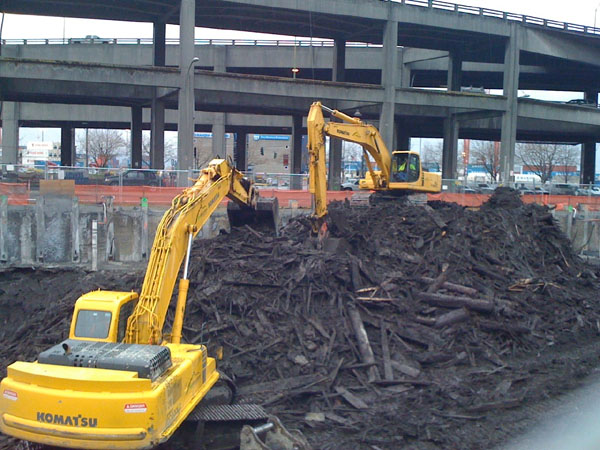Where not to go swimming in Casco Bay
Tonight, Portland's City Council will vote on a 25-year plan to reduce the amount of sewage that gets dumped into Casco Bay during wet weather.

The green warning signs like the one pictured above (located next to the city's cruise ship dock) mark the locations of Portland's combined sewer overflow outlets. During wet weather, when millions of gallons of rainwater flow into storm drains and overwhelm sewer pipes, these outlets keep sewerage from backing up into the streets, by dumping it into local waterways instead (read all the details here).
These combined sewer outlets can be found in surprising places: there are three in the heart of the Old Port, the city's tourism district, including one right next to the outdoor dining area of the Portland Lobster Company, another at the busy ferry terminal, and a third next to the city's cruise ship berth. Along with a few more further down the waterfront, these outlets collectively dump 145 million gallons of sewage into Portland Harbor in a typical year.
Seventeen more outlets ringing Baxter Boulevard, a popular city park, dump over 400 million gallons of mixed sewage into the shallow, stagnant waters of Back Cove. By way of comparison, last year's BP oil spill in the Gulf of Mexico dumped about 210 million gallons of oil into the Gulf.
Nearly twenty years into the city's efforts to separate storm drains from toilet flushings, the city has managed to shut down ten CSO outlets, including the one located nearest to the city's East End Beach, as well as most of the outlets that had dumped into Capisic Brook in the city's western suburbs. But dozens of overflow outlets still remain. The map below shows where they all are (the handful of star icons represent former outlets that have been closed):
As disgusting as this problem is, solving it won't be cheap, quick, or easy. The City is looking at a range of strategies, from building new green infastructure that can absorb rainwater into the ground before it flows into storm drains, to building huge underground storage tanks that can expand the system's capacity to hold sewage without spewing it out into the harbor.
Altogether, the recommended projects will cost the city $170 million - about $2,500 for every individual resident of the city - over the course of 25 years. That would roughly double our sewer bills, and not even then would we have a sewer system that avoids dumping sewage into Casco Bay altogether (the engineers estimate that we'd still dump 87 million gallons a year, an 88% reduction over current levels).
A fair and effective way to pay this bill would ask property owners who contribute the most to the city's sewer overflows to pay a greater share, by charging a fee in proportion to the amount of sewage and stormwater their properties send into the pipes. A one-inch rainstorm on an acre of pavement sends 26,000 gallons of oil-soaked stormwater (the equivalent of 15,000 toilet flushes) down the drains, so the owner of a large parking lot ought to pay substantially more to fix our sewers than an apartment dweller or a homeowner with a rain-absorbing garden.
This wouldn't just be a fairer way to pay for the city's sewer upgrades - it would also encourage property owners to make their own small efforts to help relieve the amount of stormwater flowing into our sewers, whether by tearing up some pavement to install a rain garden, or by fitting in more housing units on smaller lots. Small efforts multiplied thousands of times across the city's watersheds could substantially reduce the impacts of Portland's sewer problems, and the costs of fixing them.









